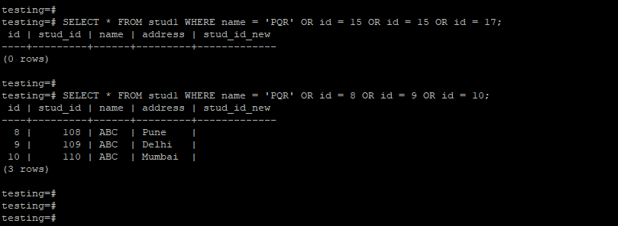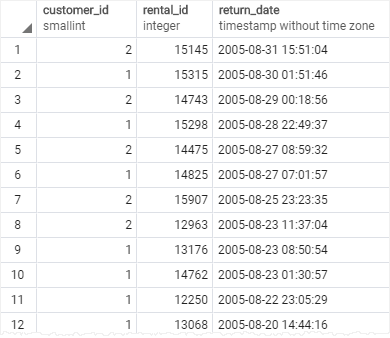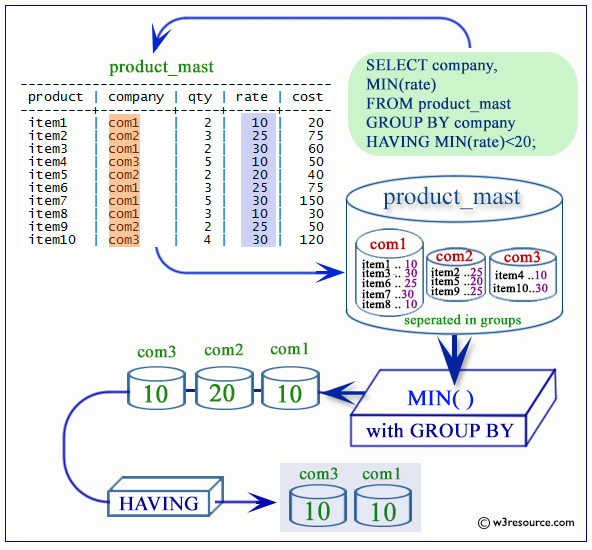

Having postgresql example how to#
Although this provides a lot of flexibility, particularly with indexing and data retention, it's cumbersome to develop and maintain, particularly deciding how to track and update aggregates with data that arrives late or has been updated in the past.
DIY processes to pre-aggregate data and store it in regular tables. Over the years, developers and databases have created numerous ways to solve this problem, usually similar to one of the following options: One of the most difficult challenges for application developers and data scientists is aggregating data efficiently without always having to query billions (or trillions) of raw data rows. Time-series data is the lifeblood of the analytics revolution in nearly every industry today. Make sure you follow us on Twitter so you don’t miss any of it! 🔥 Expect more news this week about further performance improvements, developer productivity, SQL, and more. Today, we are introducing TimescaleDB 2.7 and the performance boost it brings for aggregate queries. The FILTER clause helps to manage subsets of data that meet certain conditions, thereby avoiding aggregations.It’s time for another #AlwaysBeLaunching week! 🥳🚀✨ In our #AlwaysBeLaunching initiatives, we challenge ourselves to bring you an array of new features and content. The extension of the SQL standard through the introduction of these new clauses further facilitates the work of developers, who are increasingly able to delegate manipulation and aggregation of subsets of data to the database.īy using the WITHIN GROUP clause, the management of subsets of data that can be ordered becomes easier through the introduction of new window functions. In this particular case, this also simplifies the readability of scripts and improves execution performances. This second clause of SQL commands is useful when you want to apply filters on subsets of data without necessarilyįor example, it is now possible to perform a total count of the records of a table and also a partial code>count of one of its subsets that satisfies a certain condition (expressed by the WHERE clause) within a single query, without having to use further ones to be performed on aggregations: $ SELECT count(*) count_all, With PostgreSQL 9.4 everything is reduced to a single SQL command, resulting in significant advantages in terms of readability of the scripts and execution of the commands: $ CREATE TABLE t AS SELECT generate_series(1,20) AS val Until now, this was only possible by dividing the numbers into 4 sets via the OVER (PARTITION BY/ORDER BY) clause, then order them internally into 4 ordered subsets from which to then take the maximum value – for example, by using a CTE: $ CREATE TABLE t AS SELECT generate_series(1,20) AS val To better clarify the situation, let’s say, for example, that we want to calculate the 25th, the 50th, the 75th and the 100th percentile of the first 20 integers. rank(), dense_rank(), percent_rank(), cume_dist(): window functions already available in PostgreSQL to be executed on the subsets obtained using the OVER (PARTITION BY/ORDER BY) clause and now able to take as a parameter ordered subsets produced by the WITHIN GROUP clause. mode() a statistical function that calculates the mode on ordered. percentile_cont(), percentile_disc() for the calculation of. In addition, new functions were introduced that can be applied to these subsets and expand the collection of available window With version 9.4 of PostgreSQL the SQL WITHIN GROUP clause was introduced: this simplified many operations that had previously only been possible with the use of the window functions, defining aggregations of ordered subsets of data. PostgreSQL introduced window functions since version 9.0 in order to work on subsets of data that can be correlated to each current record of tables, defining a sort of “aggregates” centred on any specific record as the query is gradually executed via the SQL OVER(PARTITION BY/ORDER BY) clause and by using the functions that can be performed on those aggregations. The WITHIN GROUP clause is particularly useful when performing aggregations on ordered subsets of data. PostgreSQL 9.4 extends the SQL standard by inserting two new clauses that facilitate many operations required during the development of applications: the WITHIN GROUP and FILTER clauses. 

PostgreSQL 9 Cookbook – Chinese Edition.PostgreSQL Server Programming Cookbook – 2nd Edition.

PostgreSQL 9 Administration Cookbook – 3rd Edition.PostgreSQL High Availability Cookbook – 2nd Edition.








 0 kommentar(er)
0 kommentar(er)
